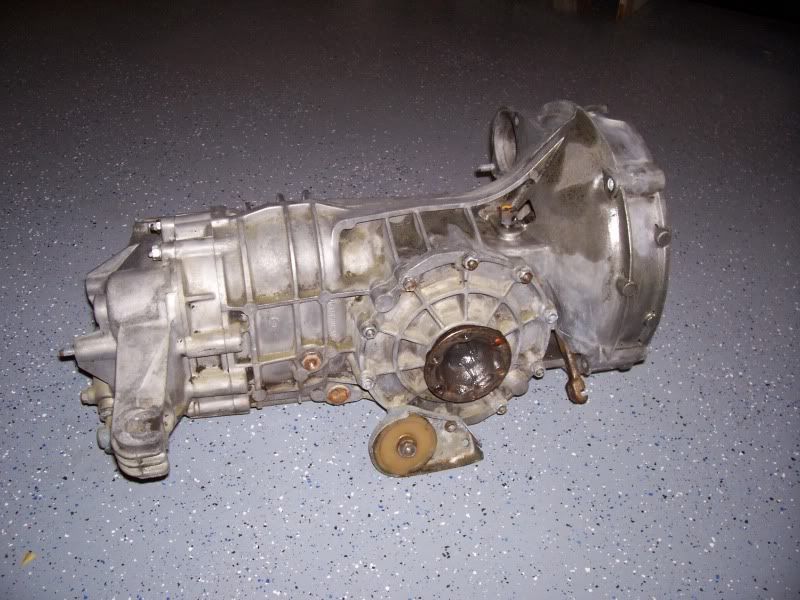David - Sorry.....Been away doing "Grampa" things with the kids.
I had several issues that I had lived with for a while and wanted to get over them. Those issues were:
1. A significant clutch chatter, particularly on very hot days, but might come and go when cold. I have a Kennedy Stage 1 (1700#) which came with a sprung disk from Kennedy. It's chattered since day one and, after 16 years of living with it, adjusting the Bowden tube and generally screwing around to make it better, I had had enough. I replaced the Kennedy sprung disk with a HD VW unsprung disk from Sachs Germany. Chatter cured. I'm not worried about future wear - I tend to be pretty easy on clutches and get lots of miles out of them. All that said, I believe that the original clutch disk was slightly warped and got worse with heat.
2. An obvious de-lam of the front transmission mount (it was an original 1969 from the donor car, as were the rear tranny mounts). Here, you have your choice of stock Asian  , Stock German
, Stock German  , or HD German - I think Berg is the best source for these
, or HD German - I think Berg is the best source for these  or the Gorilla Urethane Mounts that Carey recommended. As always, the Urethane mounts are probably the strongest, but also transmit a bit more engine/transaxle noise to the cockpit.
or the Gorilla Urethane Mounts that Carey recommended. As always, the Urethane mounts are probably the strongest, but also transmit a bit more engine/transaxle noise to the cockpit.
While going to the effort of replacing all of the mounts, I figured that installing the transaxle mid-mount under a 150hp engine was a good thing, eliminating the front mount de-lam forever (it prevents the transaxle nose from moving upward on radical acceleration). I used to get a good bit of side-to-side engine wobble at idle, indicating weaker rubber mounts - that has been eliminated with the Gorilla Mounts.
At the same time, I thought the Kafer brace was a good idea, but for the next reason:
3. A shudder in the car at 68-71mph that would come and go if the speed was held constant. This, too, was there since day one and I have been trying to find out what the cause was for 15 years. Had the wheels checked for trueness (to .003" or less in all dimensions at the rim) had everything balanced a bunch of times, finally trashed my Continentals and went to Michelins and saw much improvement (and far fewer wheel weights needed), but still not perfect. I've braced the horse-shoe frame member surrounding the engine to minimize, as best one can, up and down movement and thought that adding a Kafer Brace would generally stiffen everything up. Someday, if it looks like it might make sense, I might install horizontal corner braces at the rear (taillight end) of the horse-shoe frame to eliminate any side-to-side movement of the frame/body, but right now it has improved enough that I'm ignoring it.
One other thing I did, when Rancho was rebuilding the transaxle, was ask to go to a 3:88 rear end AND replace the Super-Diff with a new one, even though it had less than 30K miles on it, thinking that it might be the cause of the shudder (because the shudder wasn't constant - it would come and go at the same speed). A long shot, but they had it apart anyway and the price was right.
4. I had excessive counter-shaft front bearing noise (inside of the tranny nosecone), especially when cruising in third gear and decelerating. This is the #1 cause of noise in a VW transaxle because of stress and relative oiling capability within the case, plus the bearings available are generally not as good as back in the 1960's and '70's. I got a "German" bearing (actually, made in Sweden) from a local Bearing supplier and sent that along to Rancho with the tranny and that's what got put in. Night and day difference. I've seen pics of the same bearing at Air-cooled.net, too.
So after all that, the car is far tighter and stiffer, but transmits a bit more engine/transaxle noise to the cockpit (as usual, hard to tell the difference over the engine exhaust noise). The vibration in the shift lever is gone and I noticed that the Kafer Bracing seems to make it even flatter going through the "Esses" at Lime Rock Raceway - the car was super-flat, but the tires were way too soft - just wait til next time when I have them pumped up!
So that's it. What was always a fun car on twisty back roads at 50-60mph or so is now also far more comfortable at 72-80 mph on a freeway. Unfortunately, I did so many changes that I can not pinpoint what did the most good.
At this point in your car's life, and as a good winter project, I would at least go with the beefier transaxle mounts (at least the HD Rubber jobbies) and a cross-member/cradle for the engine to hold it up, or something like the rear mount in a VW Bus or in the Type 3 and 4 cars. That stuff just makes sense for a Suby installation.
Good luck with this.
gn




